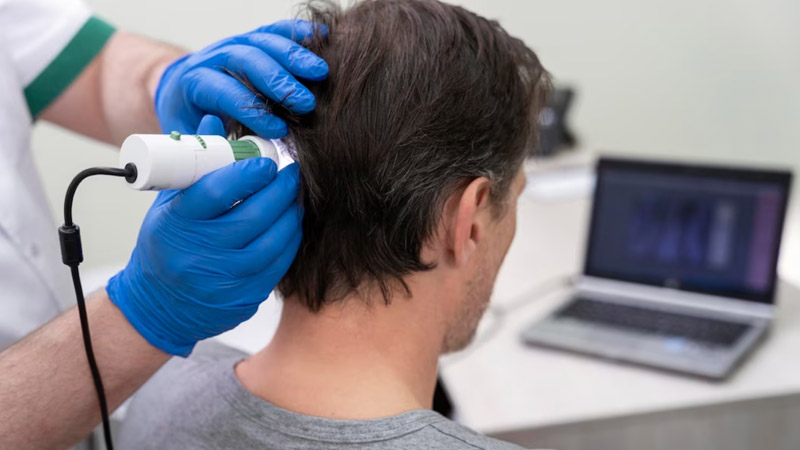
In this guide, we talk about treatment options for hair loss. Hair loss, also known as alopecia, is a common condition that affects both men and women. It can occur for various reasons and can have different patterns and degrees of severity.
Causes of Hair Loss
Androgenetic Alopecia: This is the most common cause of hair loss and is often referred to as male or female pattern baldness. It is believed to be influenced by genetics and hormonal factors.
Telogen Effluvium: This condition occurs when there is a disruption in the hair growth cycle, causing more hairs to enter the resting phase (telogen) and eventually fall out. It can be triggered by factors such as stress, hormonal changes, certain medications, and nutritional deficiencies.
Alopecia Areata: This is an autoimmune condition where the immune system mistakenly attacks the hair follicles, resulting in hair loss.
Medical Conditions: Certain medical conditions like thyroid disorders, scalp infections (such as ringworm), and autoimmune diseases can lead to hair loss.
Physical or Emotional Stress: Experiencing a traumatic event, undergoing surgery, or going through a period of intense stress can contribute to hair loss.
Types
Male Pattern Baldness: This type of hair loss is characterized by a receding hairline and thinning of the hair on the crown of the head.
Female Pattern Baldness: In women, hair loss is typically characterized by thinning of the hair on the top of the scalp, while the frontal hairline usually remains intact.
Alopecia Areata: This condition results in sudden patchy hair loss on the scalp or other parts of the body.
Telogen Effluvium: Hair shedding is diffuse and not localized to specific areas.
Hair Loss Treatment Options
Here are some treatment options for hair loss.
Medications
Minoxidil (Rogaine): This over-the-counter topical solution is applied directly to the scalp. It is available in different strengths and is used to stimulate hair growth and slow down further hair loss. Minoxidil is suitable for both men and women.
Finasteride (Propecia): This prescription medication is specifically for men with androgenetic alopecia. It works by blocking the conversion of testosterone to dihydrotestosterone (DHT), a hormone that contributes to hair loss. Finasteride helps to slow down hair loss and promote regrowth.
Dutasteride: Similar to finasteride, dutasteride is a prescription medication that inhibits the conversion of testosterone to DHT. It is sometimes used off-label for treating hair loss.
Hair Transplantation
Follicular Unit Transplantation (FUT): Also known as strip harvesting, this procedure involves removing a strip of scalp from the donor area (usually the back of the head) and dissecting it into individual hair grafts. These grafts are then transplanted into the bald or thinning areas of the scalp.
Follicular Unit Extraction (FUE): In this method, individual hair follicles are extracted directly from the donor area using a microsurgical instrument. The follicles are then implanted into the recipient area. FUE does not require a linear incision like FUT, and it leaves minimal scarring.
Low-Level Laser Therapy (LLLT)
LLLT uses red or near-infrared light to stimulate hair follicles and promote hair growth. It is a non-invasive treatment that can be performed in a clinical setting or using devices such as laser combs or helmets at home. The exact mechanisms of action are not fully understood, but it is believed to increase blood flow to the scalp and stimulate cellular activity.
Platelet-Rich Plasma (PRP) Therapy
PRP therapy involves drawing a small amount of the patient’s blood and processing it to separate the platelet-rich plasma. This plasma, which contains growth factors, is then injected into the scalp to stimulate hair growth and improve the thickness and quality of existing hair.
Microneedling
Microneedling involves using a device with tiny needles to create microscopic punctures in the scalp. This process stimulates the release of growth factors and promotes the production of collagen and elastin, which can contribute to hair growth.
Medications for Underlying Conditions
If an underlying medical condition is causing hair loss, treating that condition may help slow down or stop hair loss. For example, treating thyroid disorders, correcting nutritional deficiencies, or managing scalp infections can sometimes lead to improvements in hair growth.
Remember, the suitability and effectiveness of these treatments can vary depending on individual factors and the underlying cause of hair loss. It is essential to consult with a healthcare professional or a hair loss specialist to determine the most appropriate treatment plan for your specific situation.